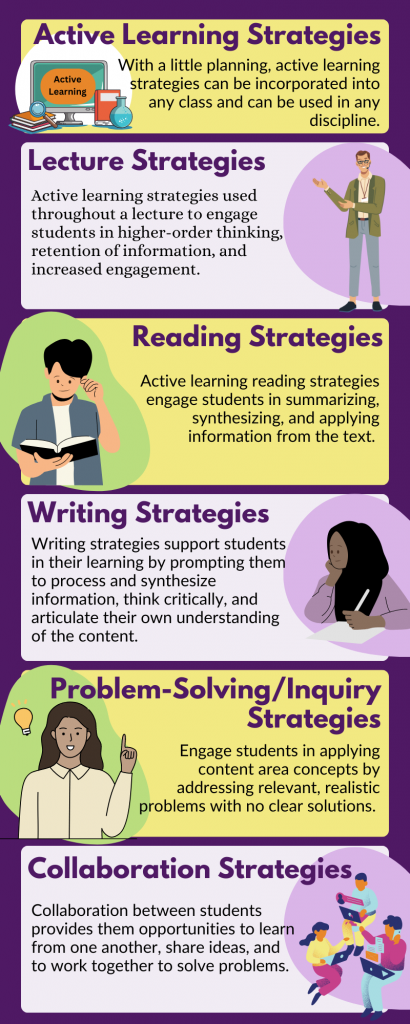
Featured Active Learning Strategy
Minute Paper – Students respond to a prompt until the set time limit is finished. This brief writing can help students consolidate information from the lecture by summarizing and articulating their understanding of the content in their own words. This increases memory and provides opportunities for clarification.
With a little planning, active learning strategies can be incorporated into any class and used in any discipline. While there are countless versions and adaptations of active learning strategies, we’ve gathered a few resources that explain some of the most effective techniques for creating more learner-centered environments.

Active Learning
Anticipation Guide & Self-Assessment – An ungraded quiz, questionnaire, or checklist for students to determine to understand topics or concepts. This taps students’ prior knowledge, primes the pump, and helps them to engage in the new content to be addressed. Valuable tools may include Microsoft Forms, D2L Quizzes or Surveys, Kahoot, or Socrative.
Polling – Before a lesson, engage students with activating, probing, or reflection questions using a system such as Poll Everywhere, the D2L Survey tool, or Zoom Polls. View more CTLE information on formative assessments and polling tools.
Brainstorming/Mind Mapping – An introduction activity where ideas and thoughts are collected, and connections between content and views are made. Tools such as Lucidchart, Canva, Miro, and various Microsoft 365 programs support brainstorming and mind-mapping capabilities and templates.
Word Cloud – Students begin with a prompt word relating to the topic, then students add words that explain or describe the prompt word. Tools that support Word Cloud are WordClouds and MonkeyLearn.
Four Corners – Using the corners of a classroom, students can move to one of four designated areas that relate to their ideas or understanding of a topic. Once in their corner, students can discuss their common knowledge with peers and then report to the class a summary of why they are there. At the end of the exercise, students may be allowed to reconsider their original perspective and move to another group based on what they heard.
Active learning strategies are used throughout a lecture to engage students in higher-order thinking, retention of information, and increased engagement.
- Think-Pair-Share – Students reflect on information/prompt for a time, then turn to a peer and share their thoughts.
- Minute Paper – Students respond to a prompt until the set time limit is finished. This brief writing can help students consolidate information from the lecture by summarizing and articulating their understanding of the content in their own words. This increases memory and provides opportunities for clarification.
- Collaborative Note-Taking – Students work together on a joint document during a lecture, allowing them to compare and consolidate notes, add missed concepts, clarify misunderstandings, and revise as needed. CTLE offers a one-hour course, CTL 123, on Collaborative Note-taking.
- Polling – Ask students activating, probing, and reflection questions throughout a lesson using a system such as Poll Everywhere, the D2L Survey tool, or Zoom Polls.
- Questioning – Ask students open-ended questions that stimulate thinking, encourage dialogue, or lead to higher-order thinking. Consider having students write down their answers first. This prompts all students to engage, not just the few who think fast and are always ready to share.
- Real-World Examples & Connections – Relate concepts and topics to real-world examples and situations, establishing relevance and connection to prior knowledge.
- Intentional Pauses – Use intentional pauses to allow students to compare notes, catch up, fill in gaps, and discuss with peers.
- Turn & Talk – Students discuss ideas or a response to a prompt. This requires all students to engage in thinking about the content.
- Picture Prompt – Students analyze or explain an image(s) using terms relevant to the lecture, content, or discipline.
- Lecture Summary – Ask students to briefly describe the lecture’s topics and concepts. This can be a quick write during or at the end of a lecture providing students the opportunity to consolidate information or ask for clarification.
- One-Sentence Summary – Challenge students to summarize the lecture into a single sentence. This prompts students to consider the lecture’s most important concept(s).
A critical active learning component is reading, where students primarily acquire new knowledge and understanding. Active learning reading strategies engage students in summarizing, synthesizing, and applying information from the text.
Concept Map – Students draw diagrams/models to show connections between topics and concepts. Relationships and interrelationships between concepts become more apparent through this exercise.
Pre-Reading – Students preview the text’s heading, subheading, visuals, and bolded text to make predictions about what they will learn.
Summary Bullet Points – Students are tasked with reducing the text to essential information in their own words.
3 Salient Quotes – Students choose three significant quotes from the text and then explain their importance.
Select an Image – Students find an image representing their reading information, followed by their reasoning.
Draw a Representation – Students create a physical representation of the key ideas from the reading. Such models require students to examine the key concepts, consider relationships, and visualize how they fit together. This strategy increases understanding and enhances memory.
Annotation – Individually or collaboratively, annotation of a text allows students to read, analyze, reflect, and discuss the assigned reading.
As an active learning strategy, writing supports students by prompting them to process and synthesize information, think critically, and articulate their understanding of the content.
- Minute Paper – Students respond to a prompt until the set time limit is finished. This brief writing can help students consolidate information from the lecture by summarizing and articulating their understanding of the content in their own words. This increases memory and provides opportunities for clarification.
- Collaborative Note-Taking – Students work together on a joint document, allowing them to compare and consolidate notes, add missed concepts, clarify misunderstandings, and revise as needed. CTLE offers a one-hour course, CTL 123, on Collaborative Note-taking.
- Lecture Summary – Ask students to briefly describe the lecture’s topics and concepts. This can be a quick write during or at the end of a lecture providing students the opportunity to consolidate information or ask for clarification.
- One-Sentence Summary – Challenge students to summarize the lecture into a single sentence. This prompts students to consider the lecture’s most important concept(s).
- Quick Writes – Ask students to recall and write their thoughts on the lecture, prompting them to reflect, summarize, or synthesize.
- Muddiest Point – Similar to a “minute paper,” except that students are asked to write where they are confused or identify their learning gaps. This allows instructors to fill in the gaps or adjust teaching strategies before advancing the content.
- Admit/Exit Slips – Students respond to a prompt with higher-order thinking questions before or after the lecture. Responses from students provide valuable formative feedback to instructors who can ascertain student understanding and adjust teaching. Exit slips also offer opportunities for retrieval practice for students, enhancing memory acquisition.
- Peer Review – Students share their writing with classmates and receive feedback via annotations and discussion.
Engage students in applying content area concepts by addressing relevant, realistic problems with no clear solutions. Problem-solving strategies keep students engaged in their learning, develop critical thinking skills, and require them to apply their knowledge to discipline-specific, real-world situations.
- Inquiry Learning – Students discover concepts, question content, and master subject matter through investigation.
- Case Studies – Students engage in problem-solving through challenging real-world scenarios
- Roleplaying – Students engage in roles apparent in real-life scenarios, experiencing various perspectives given a set of circumstances.
- Brainstorming/Mind Mapping – An activity in which ideas and thoughts about a complex problem are collected and organized, and connections are made between content and views. Students are prompted to generate possible solutions.
- Simulations – Real-world situations in which students engage as themselves (not roleplaying) in scenarios that require them to demonstrate or practice skills and behaviors learned in their course and expected in their profession. The CTLE offers a one-hour introductory course, CTL 234, about Simulated Experiences at Saint Leo for instructors interested in exploring the use of simulations in their courses.
View Active Learning Resource Pages
How to Teach a Good First Day of Class
Digital Tools to Support Active Learning
Active Learning and Classroom Community in Any Modality
University of Michigan’s Center for Research on Learning and Teaching
Berkeley’s Center for Teaching and Learning: Active Learning
Duke University’s Learning Innovation: Active Learning Techniques for the Classroom
University of Illinois Springfield’s Instructional Strategies for Online Courses
10 Creative Ways to Better Engage Your Students
15 Ways to Engage Your Students In-person, Online, and in Zoom
Annotate This: How a Common Academic Practice Can Boost Learning
Active Learning Cheat Sheet – Vanderbilt CFT
Three Ways to Prime Students for Learning | Faculty Focus
How Peer Instruction and Polling Have Changed my Teaching?
silent start. newsletter.23 (consciousteaching.com)
Building Student Ownership through Active Learning Strategies

